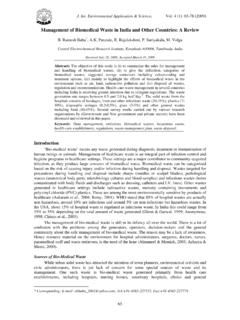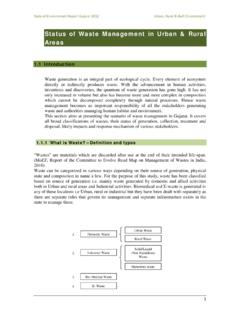Transcription of Need of Biomedical Waste Management System in …
1 INTRODUCTIONB iomedical Waste Management hasrecently emerged as an issue of major concern notonly to hospitals, nursing home authorities but alsoto the environment. the bio-medical wastesgenerated from health care units depend upon anumber of factors such as Waste managementmethods, type of health care units, occupancy ofhealthcare units, specialization of healthcare units,ratio of reusable items in use, availability ofinfrastructure and resources proper Management of biomedicalwaste has become a worldwide humanitarian topictoday.
2 Although hazards of poor Management ofbiomedical Waste have aroused the concern worldover, especially in the light of its far-reaching effectson human, health and the it is a well established fact that thereare many adverse and harmful effects to theenvironment including human beings which arecaused by the Hospital Waste generated duringCurrent World EnvironmentVol. 7(1), 117-124 (2012)Need of Biomedical Waste Management System inHospitals - An Emerging issue - A ReviewPRAVEEN MATHUR, SANGEETA PATAN* and ANAND S. SHOBHAWATD epartment of Environmental Science, MDS University Ajmer - 305 009 (India).
3 (Received: April 24, 2012; Accepted: May 27, 2012)ABSTRACTM edical care is vital for our life and health, but the Waste generated from medical activitiesrepresents a real problem of living nature and human world. Improper Management of wastegenerated in health care facilities causes a direct health impact on the community, the health careworkers and on the environment Every day, relatively large amount of potentially infectious andhazardous Waste are generated in the health care hospitals and facilities around the disposal of BMW or hospital Waste and exposure to such Waste possess seriousthreat to environment and to human health that requires specific treatment and Management priorto its final disposal.
4 The present review article deals with the basic issues as definition, categories,problems relating to Biomedical Waste and procedure of handling and disposal method of BiomedicalWaste Management . It also intends to create awareness amongst the personnel involved in healthcare unit. Key words: Hazardous Waste , Biomedical Waste Management , Health care patient care. Hospital Waste is a potential healthhazard to the health care workers, public and floraand fauna of the area. The problems of the wastedisposal in the hospitals and other health-careinstitutions have become issues of increasingconcern.
5 3 DefinitionAccording to Biomedical Waste ( Management and Handling) Rules, 1998 of India Any Waste which is generated during thediagnosis, treatment or immunization of humanbeings or animals or in research activitiespertaining thereto or in the production or testing ofbiologicals. 4 The Government of India (notification,1998) specifies that Hospital Waste Managementis a part of hospital hygiene and maintenanceactivities. This involves Management of range ofactivities, which are mainly engineering functions,such as collection, transportation, operation ortreatment of processing systems, and disposal ofwastes.
6 4118 MATHUR et al., Curr. World Environ., Vol. 7(1), 117-124 (2012)One of India s major achievements hasbeen to change the attitudes of the operators ofhealth care facilities to incorporate good HCWmanagement practices in their daily operations andto purchase on-site Waste Management servicesfrom the private sector. (Bekir Onursal, 2003)World Health Organization states that 85%of hospital wastes are actually non-hazardous,whereas 10% are infectious and 5% are non-infectious but they are included in hazardouswastes. About 15% to 35% of Hospital Waste isregulated as infectious Waste .
7 This range isdependent on the total amount of Waste generated(Glenn and Garwal, 1999).5 Classification of Bio-Medical WasteThe World Health Organization (WHO)has classified medical Waste into eight categories: General Waste Pathological Radioactive Chemical Infectious to potentially infectious Waste Sharps Pharmaceuticals Pressurized containersSources of Biomedical WasteHospitals produce Waste , which isincreasing over the years in its amount and hospital Waste , in addition to the risk for patientsand personnel who handle them also poses a threatto public health and Sources Govt.
8 Hospitals/private hospitals/nursinghomes/ dispensaries. Primary health centers. Medical colleges and research centers/paramedic services. Veterinary colleges and animal researchcenters. Blood banks/mortuaries/autopsy centers. Biotechnology institutions. Production Sources Physicians/ dentists clinics Animal houses/slaughter houses. Blood donation camps. Vaccination centers. Acupuncturists/psychiatric clinics/cosmeticpiercing. Funeral services. Institutions for disabled personsProblems relating to Biomedical wasteA major issue related to current Bio-Medical Waste Management in many hospitals isthat the implementation of Bio- Waste regulation isunsatisfactory as some hospitals are disposing ofwaste in a haphazard, improper and indiscriminatemanner.
9 Lack of segregation practices, results inmixing of hospital wastes with general Waste makingthe whole Waste stream hazardous. Inappropriatesegregation ultimately results in an incorrectmethod of Waste Bio-Medical wastemanagement thus will cause environmentalpollution, unpleasant smell, growth andmultiplication of vectors like insects, rodents andworms and may lead to the transmission of diseaseslike typhoid, cholera, hepatitis and AIDS throughinjuries from syringes and needles contaminatedwith communicable diseases, whichspread through water, sweat, blood, body fluids andcontaminated organs.
10 Are important to be Bio Medical Waste scattered in and aroundthe hospitals invites flies, insects, rodents, cats anddogs that are responsible for the spread ofcommunication disease like plague and rabies. Ragpickers in the hospital, sorting out the garbage areat a risk of getting tetanus and HIV infections. Therecycling of disposable syringes, needles, IV setsand other article like glass bottles without propersterilization are responsible for Hepatitis, HIV, andother viral diseases. It becomes primaryresponsibility of Health administrators to managehospital Waste in most safe and problem of bio-medical wastedisposal in the hospitals and other healthcareestablishments has become an issue of increasingconcern, prompting hospital administration to seeknew ways of scientific, safe and cost effective119 MATHUR et al.








